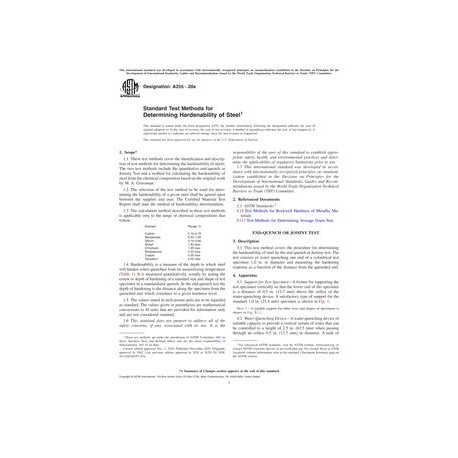No products
 View larger
View larger ASTM A255-20a
M00000625
New product
ASTM A255-20a Standard Test Methods for Determining Hardenability of Steel
standard by ASTM International, 11/01/2020
In stock
More info
Full Description
1.1These test methods cover the identification and description of test methods for determining the hardenability of steels. The two test methods include the quantitative end-quench or Jominy Test and a method for calculating the hardenability of steel from the chemical composition based on the original work by M. A. Grossman.
1.2The selection of the test method to be used for determining the hardenability of a given steel shall be agreed upon between the supplier and user. The Certified Material Test Report shall state the method of hardenability determination.
1.3The calculation method described in these test methods is applicable only to the range of chemical compositions that follow:
Element | Range, % | |
Carbon | 0.10-0.70 | |
Manganese | 0.50-1.65 | |
Silicon | 0.15-0.60 | |
Nickel | 1.50 max | |
Chromium | 1.35 max | |
Molybdenum | 0.55 max | |
Copper | 0.35 max | |
Vanadium | 0.20 max |
1.4Hardenability is a measure of the depth to which steel will harden when quenched from its austenitizing temperature (Table 1). It is measured quantitatively, usually by noting the extent or depth of hardening of a standard size and shape of test specimen in a standardized quench. In the end-quench test the depth of hardening is the distance along the specimen from the quenched end which correlates to a given hardness level.
1.5The values stated in inch-pound units are to be regarded as standard. The values given in parentheses are mathematical conversions to SI units that are provided for information only and are not considered standard.
1.6This standard does not purport to address all of the safety concerns, if any, associated with its use. It is the responsibility of the user of this standard to establish appropriate safety, health, and environmental practices and determine the applicability of regulatory limitations prior to use.
1.7This international standard was developed in accordance with internationally recognized principles on standardization established in the Decision on Principles for the Development of International Standards, Guides and Recommendations issued by the World Trade Organization Technical Barriers to Trade (TBT) Committee.

